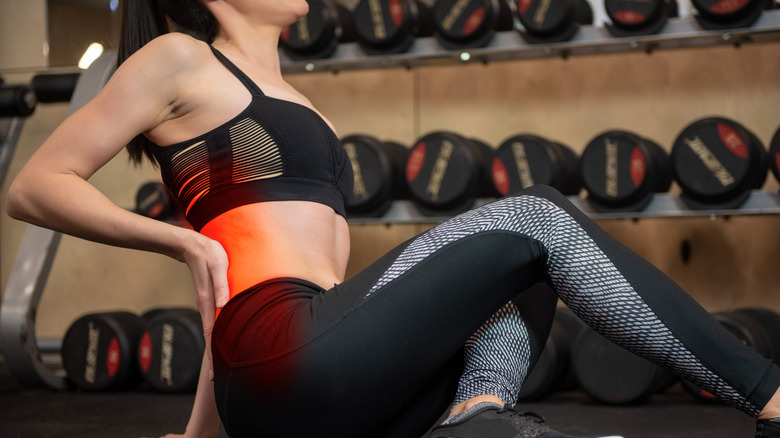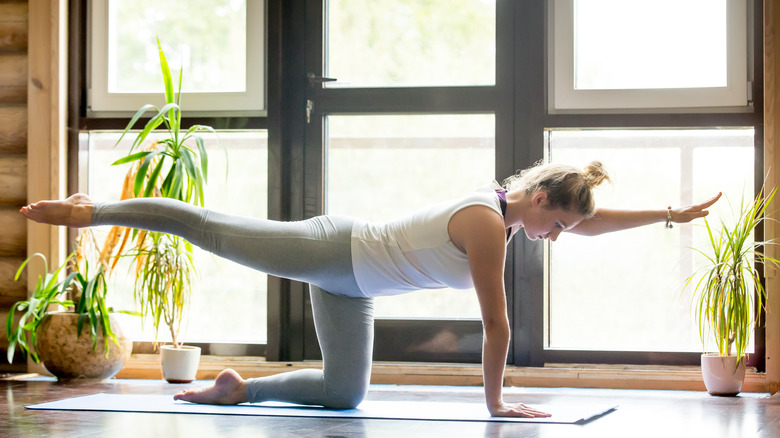Exercises You Need For Your Lower Back
Working out with lower back pain can be tricky. On one hand, you want to keep your back strong and commit to regular exercise. On the other hand, even the most basic movements can feel difficult and uncomfortable. Imagine trying to squat when you suddenly feel a sharp pain in your lower back and down the leg! Barbell back squats, deadlifts, hip thrusts, and rows all target the back muscles, but this doesn't mean they are right for you. Consider your fitness level and health needs when putting together an exercise plan.
Dr. Stuart McGill, professor emeritus in Spine Biomechanics at the University of Waterloo, states that many people "confuse health objectives ... with performance objectives (which require risk) and compromise their progress with specific strength training too early" (via BackFitPro). He also explains that chronic back pain isn't as common as we think. "What most have is repeated acute attacks all day long," Dr. McGill told Health and Fitness Education (HFE). "When we identify a specific pain trigger in that person, we then observe them and find that they keep repeating that pain trigger in their movements without realizing it," he added. Simply put, it's those micro-movements we perform on a daily basis that can cause pain.
Luckily, there are ways to build lower back strength without putting yourself at risk for injuries. Use the tips below to optimize your workouts and make every rep count.
Strengthen your back and core with Stuart McGill's 'Big Three'
Stuart McGill's "Big Three" is a series of exercises designed to increase back and core strength. These include the curl-up, bird-dog, and side bridge, according to BackFitPro. Dr. McGill recommends these movements for their ability to build muscle endurance without putting stress on the spine and joints. As you progress, you can try more advanced variations to better target the erector spinae and other back muscles.
Curl-ups, for example, require lying on your back with one leg bent. Place your hands under the lower back for support and then lift your head, shoulders, and chest without arching your back. Maintain this position for 10 seconds, relax, and repeat. Extend your leg in front of you, bend the other leg, and start all over.
The side bridge, or side plank, requires lying on your side with your weight on your right forearm. Place the other hand on your left hip or right shoulder, bend your knees, and then slowly lift your hips. Brace your core and hold for 10 seconds. Repeat several times and then switch sides. If you're up for a challenge, perform this movement with your legs straight.
The American Council on Exercise recommends performing eight or more reps for the first set. Decrease by two to six reps for the second set, and two to four reps for the third, building strength and upping the starting numbers in subsequent workouts. These guidelines apply to all three exercises, but they are not set in stone.
Improve your balance and build lower back strength with the bird-dog
The bird-dog, one of Stuart McGill's "Big Three" back exercises, engages nearly every muscle in the lower back, as well as your glutes and abs. In the long run, it may "prevent imbalance injuries that typically occur from an under-utilized back muscle and an overly tight front side of the body," says personal trainer and master coach Bethany Stillwaggon (via Byrdie). Plus, it has several variations that can be tailored to your fitness level.
If you're ready to give it a try, get on all fours and raise your left arm along with your right leg. Squeeze your abs and stabilize your hips. Hold for 10 seconds and then repeat with your right arm and left leg. Keep your spine neutral at all times. As you get stronger, use a dumbbell or elastic band for increased resistance. This movement can be performed from a high plank position, too.
Perform these exercises daily to reap the benefits. You may also try the child's pose, the saw, the side bend, pelvic tilts, and other gentle movements targeting the core and lower back muscles. If you're having back pain, avoid the shoulder press and deadlift. You can still squat, but it's best to use resistance bands or place the weight in front of you rather than on your back. Kettlebell squats, for example, are less taxing on the spine than barbell back squats.


